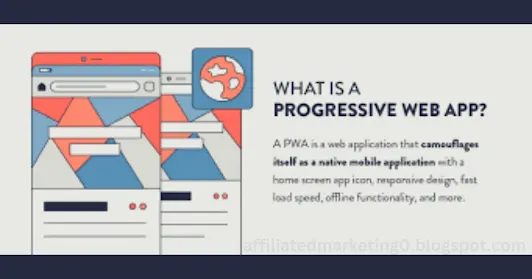Picture a website that functions perfectly, even without an internet connection. It can send you notifications and operates as smoothly and quickly as your beloved mobile app. This is the core concept of a PWA. PWAs are web applications created using standard web technologies such as HTML, CSS, and JavaScript. They utilize modern APIs to deliver an experience similar to a mobile app's.
PWAs are super cool because they can be used by anyone, no matter their device or browser. They work even when the internet is slow, so you don't have to worry about losing functionality. And the best part is, as your internet connection gets better, the experience just keeps getting better, too!
You May Also Visit This: Blockchain
Screenshot:

Core Features of PWAs
Progressive web apps have an impressive range of features that help them feel and work like regular apps.
Installability: Progressive Web Apps (PWAs) can be added to a user's device's home screen, similar to a regular app. This makes it convenient to access them quickly without having to go to a website.
Offline Functionality: Thanks to service workers, PWAs can function even without an internet connection. These little scripts work silently in the background, allowing cool features like storing content for future use.
Push Notifications: Like native applications, PWAs can deliver users timely updates and notifications, ensuring they stay engaged and well-informed.
Responsive Design: Progressive Web Applications (PWAs) are designed to adjust to various devices effortlessly, guaranteeing a top-notch user experience on desktops, tablets, and smartphones.
Fast Loading Speeds: PWAs emphasize performance, employing strategies such as pre-caching to provide breakneck loading speeds even when connected to sluggish internet networks.
Background Sync: PWAs can seamlessly synchronize data in the background, guaranteeing a seamless and uninterrupted user experience even when the application is not actively being utilized.
Benefits of Using PWAs
The benefits of PWAs are advantageous for both users and businesses. Let's delve deeper into the advantages.
For Users:
Enhanced User Experience: Progressive Web Apps provide a quicker, more dependable, and application-like user experience compared to conventional websites.
Offline Functionality: Users can access content and features without requiring an internet connection, thereby enhancing convenience and accessibility.
Push Notifications: Keep yourself informed with crucial notifications and prompts sent directly via the PWA.
No App Store Hassle: You do not need to download or update applications from app stores. Progressive Web Apps (PWAs) are automatically updated in the background.
For Businesses:
Increased Engagement: PWAs effectively engage users through push notifications and provide an app-like experience, resulting in increased conversion rates and improved customer retention.
Improved Search Engine Visibility: PWAs are known for their search engine optimization (SEO) capabilities, which enhance their search engine ranking and facilitate organic discovery.
Broader Reach: PWAs are compatible with all devices and browsers, removing the necessity to focus on particular platforms.
While PWAs share similarities with native apps, there are some key distinctions to consider:
Development: Native applications require coding languages specific to each platform, such as Swift for iOS or Java for Android. Conversely, Progressive Web Apps (PWAs) are developed using standard web technologies.
Distribution: Native applications can be downloaded from app stores, while Progressive Web Apps (PWAs) can be accessed directly through a web browser URL without the need for app store approval.
Features: Native applications can utilize specific device features such as GPS, which may not be accessible to Progressive Web Apps. Nevertheless, the disparity in functionalities is diminishing as web browsers continue to enhance their capabilities.
Building PWAs: Getting Started
Developing a Progressive Web App (PWA) is easily achievable for developers who are well-versed in web technologies such as HTML, CSS, and JavaScript. Some various frameworks and libraries can assist in simplifying the development workflow. Below are a few tools to help you begin:
Web. dev: This comprehensive guide, created by Google developers, provides detailed information on PWA concepts, best practices, and code examples: https://web.dev/explore/progressive-web-apps.
Workbox: A widely used JavaScript library can be found at this link: https://github.com/GoogleChrome/workbox. This library is designed to help developers incorporate common Progressive Web App (PWA) features such as service workers and background sync into their projects.
Meta Description:
Have you ever desired for a website to have the same seamless experience as an app? Progressive Web Apps (PWAs) are the solution, providing app-like functionality.


.webp)



0 Comments